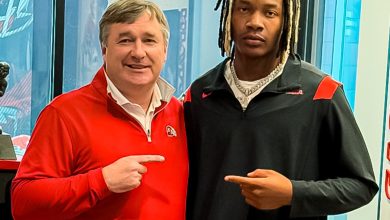Choosing my top tight ends was made simple by the Dallas Cowboys’ extensive history.

The Dallas Cowboys have long been a storied franchise with a rich tradition of excellence in the NFL. From dominant defenses to high-powered offenses, the Cowboys have been home to some of the greatest players in football history. And when it comes to tight ends, the team’s extensive history provides a solid foundation for ranking the best to ever wear the star. While many teams may struggle to find consistent talent at certain positions, the Cowboys’ tight end position has been a critical piece of the puzzle for decades, with some of the most iconic figures in NFL history making a significant impact.
As I embarked on choosing my top tight ends in Dallas Cowboys history, it became clear that the team’s history has made this task both easier and harder at the same time. Easier because of the wealth of talent the Cowboys have produced, and harder because many of these players could be considered among the best in the league’s history, making it difficult to rank them definitively. Nonetheless, by evaluating both statistical achievements and the intangible impact each tight end has had on the team’s success, I’ve compiled a list that is reflective of the Cowboys’ remarkable history at the tight end position.
1. Jason Witten: The Unquestionable No. 1
It’s hard to imagine a world where Jason Witten isn’t the top tight end in Dallas Cowboys history. The longevity, consistency, and leadership he displayed over his remarkable career make him an easy choice for the No. 1 spot. Witten’s career spanned 16 seasons with the Cowboys, making him one of the most enduring figures in the franchise’s history.
Witten’s impact on the field was immediate. Drafted in 2003, he quickly became a security blanket for quarterbacks, particularly for Tony Romo. Witten was known for his exceptional route running, strong hands, and ability to make clutch plays in key moments. He retired as the Cowboys’ all-time leader in receptions (1,152), receiving yards (12,977), and receiving touchdowns (72). His consistency and ability to stay healthy, playing in 255 games for the Cowboys, allowed him to break records and remain a focal point of the offense for nearly two decades.
Beyond the statistics, Witten’s leadership and work ethic were perhaps his most defining attributes. He was the emotional heartbeat of the team, especially during years when the Cowboys faced adversity. Whether it was a key third-down reception, a pivotal touchdown in a playoff game, or simply leading by example on and off the field, Witten made his mark as one of the league’s most reliable and respected players.
Witten’s 2012 season, in which he recorded 110 receptions for 1,039 yards, is one of the best seasons by a tight end in NFL history, showcasing his ability to dominate in both the short and intermediate passing game. His resilience to maintain a high level of play well into his 30s, even when injuries began to take their toll, is a testament to his physical and mental fortitude.
Jason Witten’s legacy with the Cowboys is not just about statistics, but the impact he had on the organization’s identity. He set a standard for tight ends across the NFL, becoming a model for consistency and professionalism that will resonate for years to come.
2. Doug Cosbie: The Original Cowboys’ Star Tight End
Before Jason Witten, the Dallas Cowboys’ tight end position was already producing top-tier talent, with Doug Cosbie leading the way in the 1970s and early 1980s. Cosbie played for the Cowboys from 1979 to 1987 and was a key contributor during the team’s successful years in the NFC East. He was an athletic, dynamic tight end known for his ability to stretch the field and create mismatches against defenders.
What made Cosbie so special was his ability to both block effectively and catch passes, making him a versatile weapon in the Cowboys’ offense. As a receiver, Cosbie recorded 6,249 yards and 31 touchdowns during his career, with his most productive seasons coming in the early 1980s. His best season came in 1983, when he caught 49 passes for 724 yards and 4 touchdowns, leading the Cowboys in receiving yards that year.
Cosbie played a critical role in the Cowboys’ passing game, especially in an era when the tight end was primarily used as an additional blocker. He was one of the first tight ends in the NFL to showcase the ability to be a downfield threat, making him a key part of the offense. Additionally, Cosbie’s blocking skills were integral in helping the Cowboys maintain a balanced offense, which paved the way for the team’s success.
Though Cosbie played before the era of the high-flying passing game, his contributions helped set the stage for future tight ends like Witten. Cosbie’s combination of size, speed, and athleticism remains a hallmark for future Cowboys tight ends to follow, solidifying his place as one of the best in franchise history.
3. Jay Novacek: The Unsung Hero of the 1990s Cowboys Dynasty
When you think about the Cowboys’ dominance in the 1990s, names like Troy Aikman, Emmitt Smith, and Michael Irvin often dominate the conversation. However, one player who was vital to the team’s success during that decade was tight end Jay Novacek. Known for his reliability, exceptional hands, and ability to make clutch catches, Novacek played a key role in helping the Cowboys win three Super Bowls during his tenure with the team from 1990 to 1995.
Novacek wasn’t the flashiest tight end, but his effectiveness and consistency made him an integral part of the Cowboys’ offense. He caught 3,503 yards and 22 touchdowns in his six seasons with Dallas. His best season came in 1992, when he recorded 68 receptions for 721 yards and 5 touchdowns, providing Aikman with another reliable target in the passing game.
What set Novacek apart was his ability to thrive in critical moments, often coming through with key receptions in crucial situations. Whether it was a tough third-down conversion or a touchdown in the red zone, Novacek consistently found ways to make an impact when it mattered most. He was especially effective in the postseason, where his solid performances were crucial to the Cowboys’ Super Bowl runs in the 1990s.
While Novacek was never a huge statistical powerhouse, his ability to contribute to the team’s success in big games cannot be overstated. His contributions to the Cowboys’ championship years earned him a well-deserved place among the franchise’s best tight ends.
4. Billy Joe DuPree: The Cowboys’ First Pro Bowl Tight End
Another standout tight end for the Cowboys during their early years was Billy Joe DuPree, who played for the team from 1973 to 1981. DuPree was one of the first Cowboys tight ends to gain widespread recognition, earning a Pro Bowl selection in 1977 and becoming a key piece of the team’s offensive success during that era.
DuPree was known for his strong blocking ability and reliable hands in the passing game. His combination of size and agility made him a valuable target for quarterback Roger Staubach, and his steady play helped solidify the Cowboys’ offense during their Super Bowl run in the 1970s. He caught 3,337 yards and 22 touchdowns during his career, with his best season coming in 1978, when he recorded 56 receptions for 778 yards and 6 touchdowns.
While DuPree might not have had the long-lasting career that some of the other names on this list enjoyed, his contributions were crucial during the Cowboys’ peak years in the 1970s. His solid all-around play and leadership on the field helped set the stage for future generations of tight ends to thrive in Dallas.
5. Gavin Escobar: A Brief But Impactful Career
Gavin Escobar’s time with the Cowboys may have been shorter than many would have hoped, but his ability to contribute as a receiving tight end during his tenure still makes him an intriguing figure in Cowboys history. Drafted in the second round of the 2013 NFL Draft, Escobar came into the league with high expectations as a dual-threat tight end who could both block and catch passes.
Although Escobar’s career with the Cowboys was relatively brief (he played with the team from 2013 to 2016), he managed to record 30 receptions for 333 yards and 8 touchdowns during his four seasons with the team. Escobar’s most significant contributions came in the red zone, where he demonstrated a knack for making difficult catches and scoring touchdowns. His best season came in 2014, when he caught 8 passes for 132 yards and 4 touchdowns.
While Escobar’s career didn’t reach the heights of other Cowboys tight ends, his ability to make key contributions in the limited role he played still leaves a mark on the team’s history. His impact on Dallas’ offensive success during the 2014 season should not be overlooked.
A Legacy of Tight End Excellence
The Dallas Cowboys have been fortunate to have some of the best tight ends in NFL history play for the franchise. From Jason Witten, who set the gold standard for tight ends in both performance and leadership, to players like Doug Cosbie, Jay Novacek, and Billy Joe DuPree, who each played crucial roles in the team’s success, the Cowboys’ tight end position has been a key part of the team’s identity.
As I reflect on the legacy of these players, it becomes clear that the Cowboys’ extensive history at the tight end position has shaped not only the team’s success but also the way the tight end position is viewed across the NFL. Whether as a reliable blocker, a red-zone target, or a primary receiver, Cowboys tight ends have consistently elevated the offense, becoming indispensable players who are crucial to the team’s identity.
Ultimately, the choice of top tight ends for the Cowboys’ history is a testament to the team’s enduring success and commitment to excellence at the tight end position. Their contributions will continue to resonate in Dallas for years to come.









